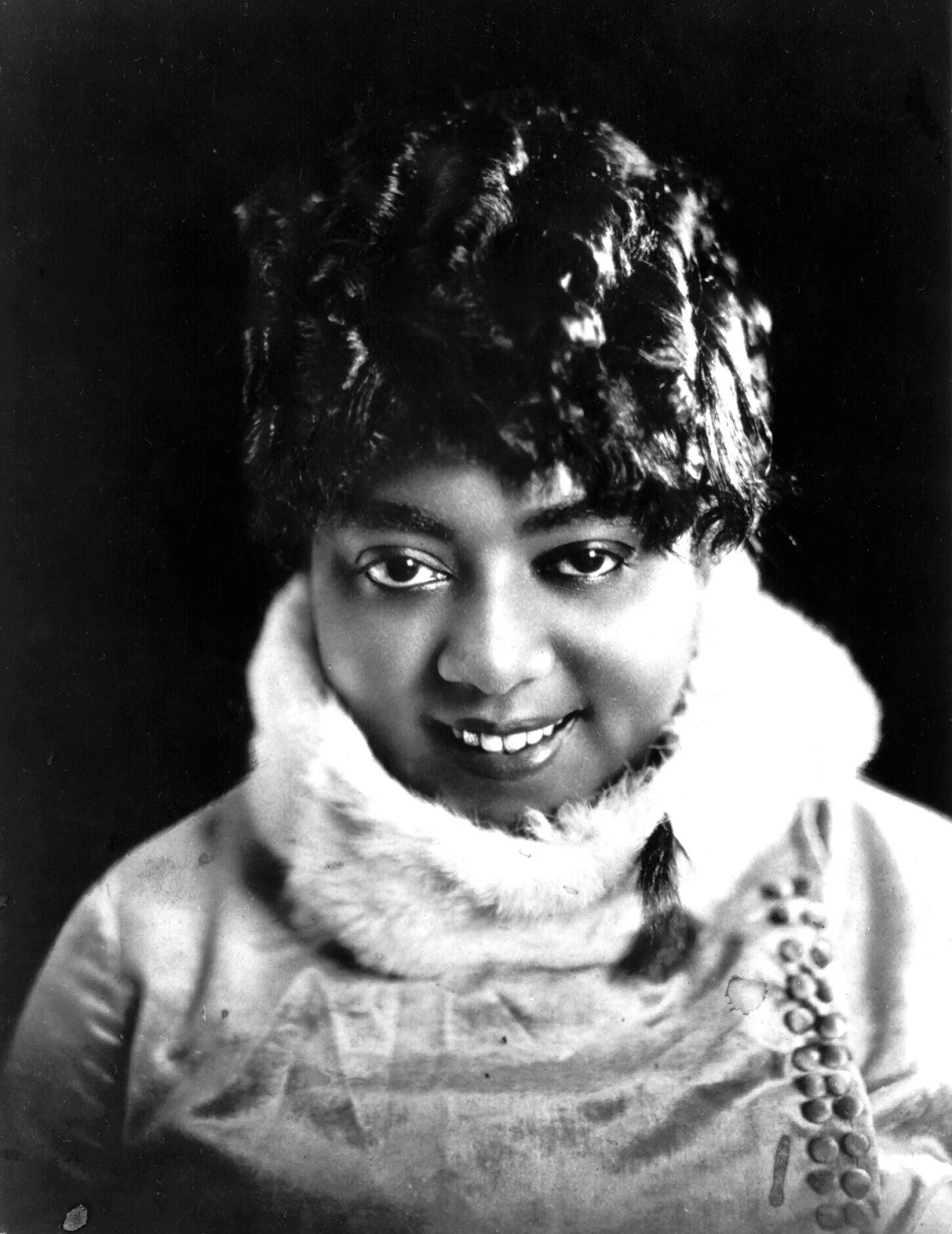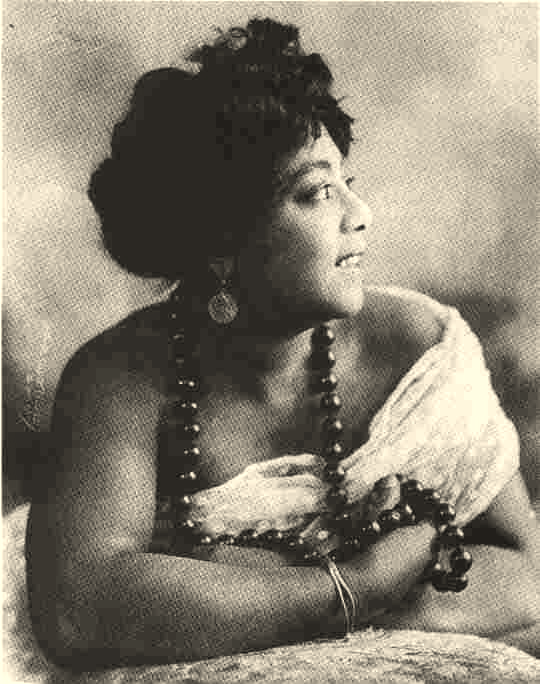MAMIE SMITH
Cada día que pasa se demuestra que los refranes son conclusiones sabias de nuestros ancestros para definir situaciones vividas que inexorablemente se van repitiendo , un ejemplo : En casa del herrero cuchilo de palo . Esto mismo nos lo aplicamos al confeccionar este post sugerencia de Nathalie Da Costa. Si bien Mamie Smith había aparecido en nuestro blog en diferentes ocasiones como figura complementaria , nunca se le había dedicado un post específico dedicado a su figura. Bien , repetimos gracias a Nathalie por su sugerencia y ahí va !
Mamie Smith (Cincinnati, 26 de mayo de 1883 - Nueva York, 16 de septiembre de 1946), conocida como la «primera dama del blues», fue una cantante, bailarina, pianista y actriz norteamericana. Como cantante, se movió entre el jazz y el blues y entró en la historia como la primera mujer afroamericana que grabó un disco, en 1920.
Viajó en un espectáculo afroamericano hasta fijar su residencia en Nueva York en 1913. Allí trabajó como cantante de cabaret. Allí conoció al compositor Perry Bradford actuando en el musical "Made in Harlem" en 1918.
En 1920, OKeh Records planeó grabar un disco con la popular cantante Sophie Tucker con un par de canciones de Bradford. Tucker enfermó y no pudo realizar la sesión así que Bradford convenció a la discográfica a que Mamie Smith ocupara el puesto de Tucker. Smith grabó dos canciones ("That Thing Called Love" y "You Can't Keep A Good Man Down") el 14 de febrero de 1920 con la banda blanca del estudio. La buena actuación de Smith hizo que fuera invitada a realizar más canciones. El 10 de agosto de 1920, Smith grabó otra canción de Bradford "Crazy Blues" (que en 2005 fue elegida como pieza artística de preservación de la Biblioteca del Congreso de los Estados Unidos), "It's Right Here For You, If You Don't Get It" y 'Tain't No Fault of Mine". Ésta fueron las primeras grabaciones de blues de una cantante afroamericana y el disco fue uno de los más vendidos del año. Después del éxito de Mamie Smith, las compañías discográficas se lanzaron a la grabación de cantantes negros. Y es que, aunque otros afroamericanos habían grabado anteriormente (como el caso de George W. Johnson a finales del siglo XIX), eran cantantes de color con un gran seguimiento de público blanco. Pero el éxito de Smith radicó en que las compañías empezaron a buscar otras cantantes negras de blues para empezar la época dorada de las cantantes de blues. Además, Smith abrió la puerta a que cantantes negros pudieran grabar en otro géneros que no estrictamente el blues.
Mamie Smith continuó su serie de éxitos para Okeh en la década de los 20. Viajó por todo Estados Unidos y por Europa con su banda "Mamie Smith & Her Jazz Hounds" como parte de su "Mamie Smith's Struttin' Along Review".1 Fue llamada "La Reina del Blues", aunque poco después Bessie Smith fuese llamada "La emperatriz del Blues".
Mamie Smith apareció en la película sonora Jail House Blues 1929, retirándose inicialmente en 1931. Volvió en 1939 para aparecer en la película Paradise in Harlem, Mystery in Swing, Sunday Sinners (1940), Stolen Paradise, Murder on Lenox Avenue (1941), y Because I Love You (1943).
Mamie Smith (née Robinson; May 26, 1891 – September 16, 1946) was an American vaudeville singer, dancer, pianist and actress. As a vaudeville singer she performed in various styles, including jazz and blues. In 1920, she entered blues history as the first African-American artist to make vocal blues recordings. Willie "The Lion" Smith (no relation) described the background of that recording in his autobiography, Music on My Mind (1964).
Robinson was born in Cincinnati, Ohio in 1891. The year of her birth has previously been given as 1883 but in 2018, researcher John Jeremiah Sullivan discovered her birth certificate stating she was born in 1891 in Cincinnati.
When she was around 10 years old, she found work touring with a white act, the Four Dancing Mitchells. As a teenager, she danced in Salem Tutt Whitney's Smart Set. In 1913, she left the Tutt Brothers to sing in clubs in Harlem and married William "Smitty" Smith, a singer.
Musical career
On February 14, 1920, Smith recorded "That Thing Called Love" and "You Can't Keep a Good Man Down" for Okeh Records, in New York City, after African-American songwriter and bandleader Perry Bradford persuaded Fred Hagar to break the color barrier in black music recording. Okeh Records went on to record many iconic songs by black musicians. Although this was the first recording by a black blues singer, the backing musicians were all white. Hagar had received threats from Northern and Southern pressure groups saying they would boycott the company if he recorded a black singer.Despite these threats the record was a commercial success and opened the door for more black musicians to record.
Smith's biggest hit was recorded later, on August 10, 1920 when she recorded a set of songs written by Perry Bradford, including "Crazy Blues" and "It's Right Here for You (If You Don't Get It, 'Tain't No Fault of Mine)", again for Okeh Records, A million copies were sold in less than a year. Many were bought by African Americans, and there was a sharp increase in the popularity of "race records".Because of its historical significance, "Crazy Blues" was inducted into the Grammy Hall of Fame in 1994 and was selected for preservation in the National Recording Registry of the Library of Congress in 2005.
Although other African Americans had been recorded earlier, such as George W. Johnson in the 1890s, they were performing music that had a substantial following among European-American audiences. The success of Smith's record prompted record companies to seek to record other female blues singers and started the era of what is now known as classic female blues.
Gravure of Smith in the New York Clipper, 1921
Smith continued to make popular recordings for Okeh throughout the 1920s. In 1924 she made three releases for Ajax Records, which, while heavily promoted, did not sell well.She made some records for Victor. She toured the United States and Europe with her band, Mamie Smith & Her Jazz Hounds, as part of Mamie Smith's Struttin' Along Review.
She was billed as "The Queen of the Blues", a billing soon one-upped by Bessie Smith, who was called "The Empress of the Blues". Mamie found that the new mass medium of radio provided a means of gaining additional fans, especially in cities with predominantly white audiences. For example, she and several members of her band performed on KGW in Portland, Oregon, in early May 1923 and received positive reviews.
Various recording lineups of the Jazz Hounds included (from August 1920 to October 1921) Jake Green, Curtis Moseley, Garvin Bushell, Johnny Dunn, Dope Andrews, Ernest Elliot, Porter Grainger, Leroy Parker and Bob Fuller and (from June 1922 to January 1923) Coleman Hawkins, Everett Robbins, Johnny Dunn, Herschel Brassfield, Herb Flemming, Buster Bailey Cutie Perkins, Joe Smith, Bubber Miley and Cecil Carpenter.
While recording with the Jazz Hounds, she also recorded as Mamie Smith and Her Jazz Band, comprising George Bell, Charles Matson, Nathan Glantz, Larry Briers, Jules Levy, Jr., Joe Samuels, together with musicians from the Jazz Hounds, including Coleman, Fuller and Carpenter.
Film career and later years
Smith appeared in an early sound film, Jailhouse Blues, in 1929. She retired from recording and performing in 1931. She returned to performing in 1939 to appear in the motion picture Paradise in Harlem, produced by her husband, Jack Goldberg.
She also appeared in other films, including Mystery in Swing (1940), Sunday Sinners (1940), Stolen Paradise (1941), Murder on Lenox Avenue (1941), and Because I Love You (1943).
Death
Smith died in 1946 in New York, New York,[20] reportedly penniless. She was interred in unmarked ground at Frederick Douglass Memorial Park on Staten Island until 2013, when a monument was finally erected.
Initially, according to the Jas Obrecht Music Archive website, Smith was buried in an unmarked grave until 1963, when musicians from Iserlohn, West Germany used the money from a Hot Jazz benefit to buy a headstone that read “Mamie Smith (1883–1946): First Lady of The Blues”. With the help of fellow blues singer Victoria Spivey and Record Research Magazine publisher Len Kunstadt, Smith was re-interred at Frederick Douglass Memorial Park in Richmond, New York. Smith’s re-interment was celebrated with a gala honoring the late singer on January 27, 1964.
However, according to the 2012 campaign website, Mamie Smith was still buried without a headstone 67 years after her death in 1946.
A successful campaign to finally acquire and erect a headstone for Smith was begun in 2012 by Michael and Anne Fanciullo Cala. The couple -- a blues journalist and editor, respectively -- developed a months-long crowdfunding campaign on the Indiegogo Web site to purchase a headstone for Smith. The philanthropy Music Cares also supported the effort.The campaign raised over $8000 that funded creation of a four-foot-high etched granite headstone featuring an image of the late blues singer.
The monument was erected with great fanfare at Frederick Douglass Cemetery in Staten Island, New York, on September 20, 2013. Excess funds from the campaign were donated to the cemetery for grounds care.






Comments